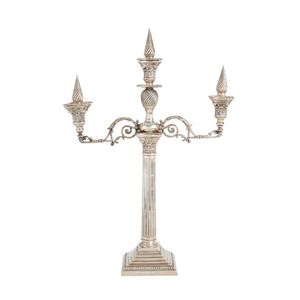George V sterling silver three-light candelabrum in Regency style
A George V sterling silver three-light candelabrum in Regency style, Rosenzweig, Taitelbaum & Co., London, 1920s (date marks rubbed), the elevated central light flanked by two further lights on scrolling branches raised on a Corinthian column on stepped base, the upper part removable to allow use of the lower part as a single candlestick, with removable nozzles and finial caps, 54.5 cm high, 38 cm wide, 12.5 cm deep, 2,720g (including loaded base)
You must be a subscriber, and be logged in to view price and dealer details.
Subscribe Now to view actual auction price for this item
When you subscribe, you have the option of setting the currency in which to display prices to $Au, $US, $NZ or Stg.
This item has been sold, and the description, image and price are for reference purposes only.
- Regency Period - The Regency period in English furniture design refers to the period when King George III, was declared unfit to rule in 1811, and his son ruled as proxy as Prince Regent, until 1820, and then, after the death of his father as George IV until his death in 1830. The Regency period was preceded by the Georgian period (George I, George II, and George III: 1714 - 1811), and was followed by the William IV period, which only lasted until 1837 when William IV died as was succeeded by Queen Victoria.
- Finial - An architectural decoration, found on the upper parts of of an object. On furniture they are usually found on pediments, canopies and shelf supports. On smaller ceramic or silver items, such as spoons, they may decorate the top of the item itself, or the lid or cover where they provide a useful handle for removal.
Finials have a variety of shapes and forms. They may be urn-shaped, baluster shaped round or spiral, but usually taper into an upper point. Many real life shapes may also be used as finials, such as pineapples, berries, pinecones, buds, lotus and acorns. Sometimes animals such as a lion are depicted, or fish and dolphins. - George V - George V (1865 ? 1936) was King of the United Kingdom and the British Dominions, and Emperor of India, from 1910 until his death in 1936.
- Sterling Silver - Sterling silver is a mixture of 92.5% pure silver and 7.5% of another metal, usually copper. Fine silver is 99.9% pure silver, and is relatively soft and the addition of the very small amount of copper gives the metal enough strength and hardness to be worked into jewellery, decorative and household objects.
- Loaded (candlestick) - A loaded candlestick has a hollow base that has been filled with a weight such as sand or lead shot to make it more stable and less likely to tip over. This method of stabilising candlesticks was in use during the 18th century, when large and ornate candlesticks were in vogue. The under base of the candlestick was designed to be detachable so that it could be filled with the weight, and the top of the candlestick usually featured a cup or spike to hold the candle securely in place.
This item has been included into following indexes:
- candelabra / candelabrum - silver items 205
- candlesticks, silver
